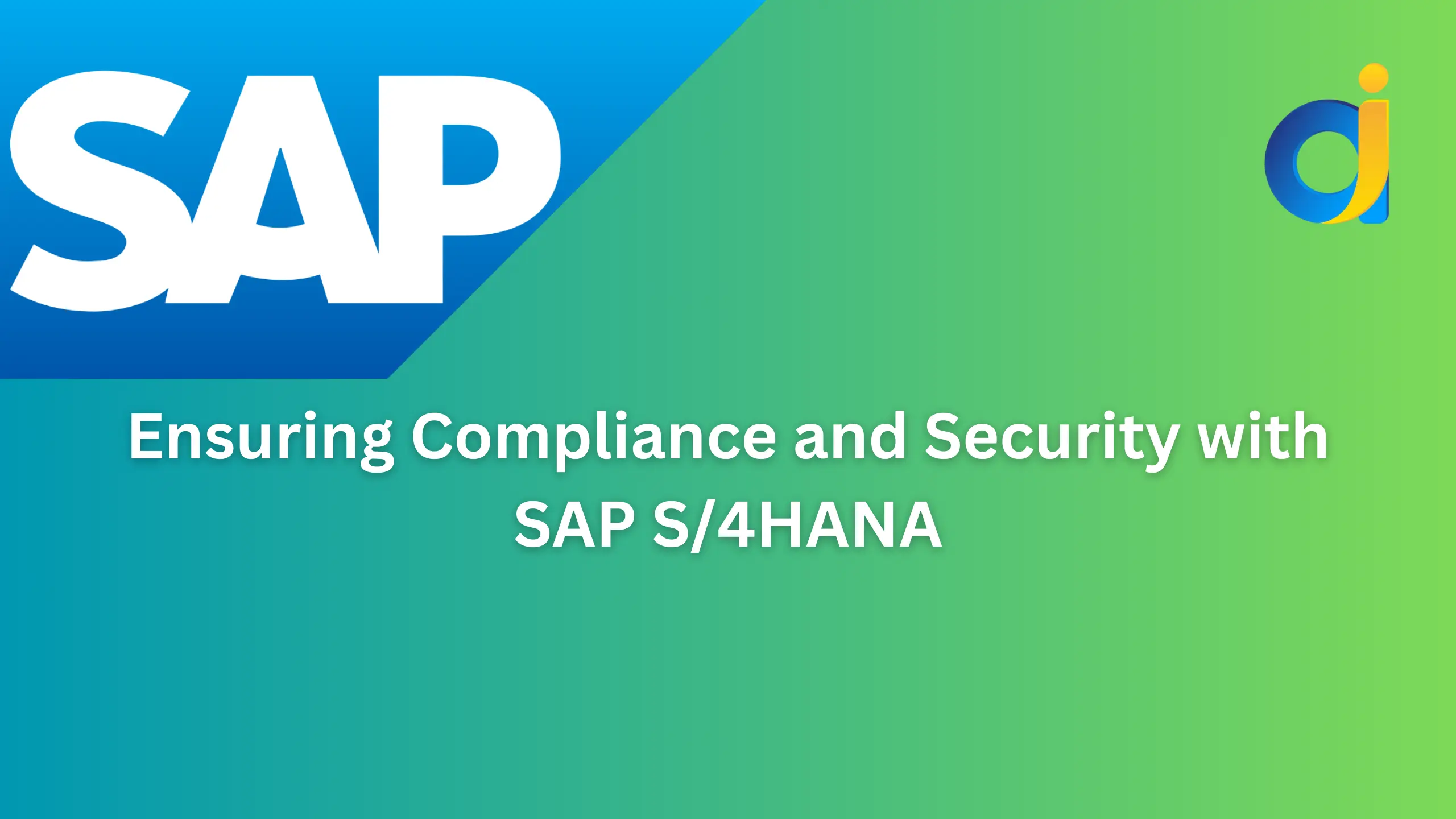Are you worried about keeping your financial systems safe? SAP S/4HANA offers a new way to manage this. This article will show you how to stay on top of risks and rules. Read on for simple advice.
Key Takeaways
- SAP S/4HANA helps protect against cyber threats by offering features like access control, data encryption, and regular security updates. These tools help stop unauthorised access to sensitive information.
- Not keeping SAP S/4HANA secure can lead to huge financial losses due to data breaches, legal issues from not following laws like SOX or GDPR, and harm a company’s reputation severely.
- It is important to constantly check your SAP system for any weak spots and update it with the latest security patches. Also, using strong passwords and controlling who has access to what information are key steps in preventing cyberattacks.
- Encryption of stored data provides a solid defence against hackers. Companies should use strong encryption methods for data at rest and in transit to keep sensitive details safe from unauthorised access.
- Keeping SAP S/4HANA updated with enhancement packs is vital as these improvements fix bugs and close loopholes that could be exploited by cyber attackers.
Understanding SAP S/4HANA Security and Compliance
SAP S/4HANA plays a crucial role in safeguarding company data against cyber threats and ensuring that operations meet strict regulations. This software helps businesses manage their financial information, customer data, and other sensitive details securely.
With features such as access control, data encryption, and regular security updates, SAP S/4HANA provides robust protection for enterprises operating in the digital age. These tools are essential for preventing unauthorised access to confidential records and avoiding costly data breaches.
Securing SAP S/4HANA involves more than just setting up defences; it demands continuous vigilance to adapt to new cybersecurity challenges. Organisations must regularly review their security measures and update them to guard against evolving threats.
Implementing best practices like multi-factor authentication and least privilege access can significantly enhance the system’s security posture. As cyberattacks become more sophisticated, having a strong foundation of IT security becomes indispensable for businesses aiming to protect their assets and comply with regulatory standards.
Moving forward, understanding the potential risks associated with inadequate SAP S/4HANA security is key to strengthening your enterprise’s defences.
Risks of Inadequate SAP S/4HANA Security and Compliance
Moving from understanding the basics of SAP S/4HANA’s security and compliance to exploring its risks reveals a critical transition. If firms fail to uphold stringent SAP security and regulatory measures, they expose themselves to an array of significant dangers.
Data breaches, one notable risk, can inflict massive financial losses; projections suggest such breaches may cost over $5 trillion by 2024. Beyond monetary damage, inadequate security measures leave room for unauthorised access—a gateway for cyber attackers to exploit vulnerabilities within cloud computing and data governance systems.
Organisations also face legal repercussions when failing to adhere to laws like SOX or the GDPR. Non-compliance leads not only to hefty fines but can tarnish a company’s reputation permanently, making recovery difficult.
Cyber insurance rates could skyrocket as well after incidents are reported. For those enterprises relying heavily on ERP systems like SAP S/4HANA for daily operations, ensuring robust cybersecurity becomes indispensable in guarding against malicious threats that aim at their confidential information and infrastructure-as-a-service offerings.
A stitch in time saves nine; neglecting SAP S/4HANA’s security today could lead an enterprise into tomorrow’s cybersecurity ordeal.
Challenges in Ensuring SAP S/4HANA Security Compliance
Understanding the risks linked with inadequate security and compliance lays the groundwork for grasping the hurdles companies face in this area. One major challenge is staying on top of regular health checkups and security assessments within SAP environments.
These tasks are vital for spotting weaknesses before they can cause harm.
Firms also struggle with managing manual processes, especially when relying on external services or integrating different products into one system. With data breach costs expected to soar, it’s clear that failing to navigate these challenges could have severe financial implications.
Furthermore, ensuring that all users have proper access controls and that data storage is secure adds layers of complexity to an already demanding task.
Best Practices for SAP S/4HANA Security and Compliance
To keep SAP S/4HANA safe, experts suggest always watching who can access what and making sure data stays protected. They say to update software often, find security weak spots, and use strong protection for stored information.
Monitoring User Activity and Access Controls
Keeping tabs on who does what in your SAP S/4HANA system is key. This means tracking every user’s actions and making sure only the right people can reach sensitive information. Use tools like dashboards to watch activities in real-time.
This helps you spot any strange behavior fast, stopping potential threats before they turn into big problems.
Setting up controls on who can access different parts of the system is also crucial. You should assign roles based on what tasks someone needs to do their job and nothing more. This approach, known as “least privileged” access, ensures that even if someone’s login details get stolen, the damage they can do is limited.
Always check and update these permissions to keep them tight but fair.
Ensuring Secure and Encrypted Data Storage
Secure and encrypted data storage stands as a critical defence against cyber threats. Companies must adopt encryption methods for both data-at-rest and data in transit to safeguard sensitive information like patient records, financial details, and personal identifiable particulars.
Utilising a strong key management system ensures that the cryptographic keys remain out of the wrong hands.
Encryption is not just a technical term; it’s a business necessity.
Firms should also embrace cloud-based storage solutions with built-in security features such as end-to-end encryption. This prevents unauthorised access during the transfer of information across networks.
By regularly updating security patches, businesses can close vulnerabilities, keeping their databases secure against emerging threats.
Timely Updates on Enhancement Packs
Keeping your SAP S/4HANA system updated with the latest enhancement packs is crucial. These updates bring new features and improvements that can boost your system’s efficiency and security.
They also fix bugs and close security loopholes, making it harder for cyber attackers to exploit vulnerabilities. By staying on top of these updates, you ensure that your enterprise resource planning (ERP) solution remains secure against potential threats.
Applying these enhancement packs promptly protects your data and helps maintain compliance with changing regulations. Whether it’s safeguarding personal information or meeting industry standards, timely updates play a key role.
They not only enhance the functionality of your cloud-based solutions but also strengthen risk management practices by keeping security measures up-to-date. This proactive approach supports a strong defense against cyber risks, ensuring that confidential information stays protected across all business functions.
Identifying Security Gaps
To find security gaps, one must regularly check the system for weak spots. This involves examining user activities and making sure only authorised people can access sensitive information.
Regular assessments give a clear picture of the system’s health, revealing areas that might invite cyberattacks.
Employing threat detection techniques is vital in spotting unusual patterns that could signal a breach. Analysis should cover all parts of SAP S/4HANA, including data storage and transmission processes.
These practices help highlight vulnerabilities before they turn into serious threats, keeping data secure and operations running smoothly.
The Role of SAP S/4HANA in Business Modernisation
SAP S/4HANA plays a crucial role in shaping future-ready businesses. This advanced platform supports companies as they adapt to digital trends, offering tools for detailed audit logs, reporting functions, and automatic compliance checks.
Businesses gain the ability to streamline processes across finance, manufacturing, and supply chain management with enhanced efficiency and transparency. Through role-based permissions, SAP ensures that sensitive information remains secure while automating routine tasks.
This system not only facilitates data security on cloud-hosted solutions but also pushes enterprises towards sustainable business practices by integrating emerging technologies like machine learning and artificial intelligence into everyday operations.
The agility offered by SAP S/4HANA enables firms to react swiftly to market changes or regulatory demands without sacrificing operational integrity or data protection standards. As industries move deeper into the era of Industry 4.0, adopting such a powerful tool becomes indispensable for modernisation efforts that keep pace with technological advancements and global competition.
Achieving Finance Transformation with SAP S/4HANA
Companies can revolutionise their financial management processes with SAP S/4HANA. This advanced system helps businesses automate routine tasks, such as invoicing and financial reporting, making these operations faster and more accurate.
With real-time data analysis capabilities, decision-makers get immediate insights into their financial performance. This visibility allows for quick adjustments to strategies, improving profitability.
Implementing SAP S/4HANA transforms how organisations handle governance, risk, and compliance (GRC). It streamlines the management of regulatory compliance by providing tools that ensure adherence to laws like HIPAA for health information or GDPR for data protection in Europe.
Through its secure cloud infrastructure, companies safeguard sensitive information against cyber threats while maintaining strict access controls. This not only boosts security but also enhances trust among stakeholders regarding the safety of their data.
Ultimate Guide to SAP S/4HANA Deployment
Deploying SAP S/4HANA is a key step for companies aiming to modernise their business processes and embrace digital transformation. This powerful software offers enhanced analytical and processing capabilities, but its deployment must be handled with care to ensure security and compliance at every stage.
- Start with a detailed plan: Crafting a precise roadmap for implementation helps identify critical milestones and potential challenges.
- Assemble the right team: Include experts in cloud computing services, IT security, logistics, and finance to ensure all aspects of the business are considered.
- Evaluate your current systems: Assess existing infrastructure and software to understand how SAP S/4HANA will integrate.
- Clean data before migration: Remove outdated or unnecessary information from your system to streamline the transition.
- Choose between cloud or on-site deployment: Decide if you want your system on the cloud for more flexibility or on-site for more control.
- Implement role-based access control: This limits who can see what data, enhancing confidentiality and IT security.
- Plan for ongoing training: Ensure users know how to use the new system effectively, covering everything from basic navigation to advanced features.
- Conduct regular health check-ups of the system: Early detection of issues prevents them from growing into bigger problems.
- Update regularly: Keep your system patched with timely updates on enhancement packs to protect against new threats.
This strategic approach ensures that businesses can leverage SAP S/4HANA’s full potential while maintaining stringent security standards and meeting compliance requirements efficiently.
Conclusion
Ensuring compliance and security with SAP S/4HANA is crucial for businesses. This system helps keep your data safe and follows the rules. You must watch how people use it and make sure only the right ones can get in.
Keep your information locked up tight and update the system often to stay ahead of risks. Making these steps a part of your daily routine will set you up for success, keeping your company secure and on track with legal standards.
For an in-depth exploration on deploying this system in your organisation, please read our Ultimate Guide to SAP S/4HANA Deployment.
FAQs on Compliance and Security with SAP S/4HANA






